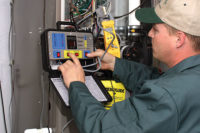“Customers can tell the difference between technicians that operate as well-oiled and organized machines,” he said. “Trucks, tools, uniforms — it’s all about image. When technicians are digging through junk to find the proper tool, it can make them appear incompetent and potentially mar their images.”
Bucket, Bag, or Box?
Despite understanding that technician images and customer perceptions are important, Crumpton does not specify how his technicians organize their tools; neither do most other contractors. That leaves the organization conundrum up to the technician.
Some choose to put their tools in five-gallon buckets. Different organizers that go over these buckets can bring a more professional look to the choice. One technician found his five-gallon buckets to be the best because of the different types of jobs he was doing on a regular basis. He was able to set up multiple buckets in advance to fit each job without hassling with his tools and wasting time.
Some technicians carry toolboxes, but many have complained that these can be awkward to close due to the bulkiness of some tools and meters. The box seems to be losing its popularity in some sectors of the HVAC market.
That leaves the bag. Tool bags seem to have grown in popularity over the years. They line the shelves of local tool stores in many shapes, sizes, and colors, for a vast list of different applications. Tool bags are as much a personal preference as the tools that go in them, but for the technicians at Isaac Heating and Air Conditioning in Rochester, N.Y., “If they have a tool bag, it is usually a Veto Pro Pac,” said Eric Knaak, vice president of operations at the company. “These bags offer the technicians organization and capacity while keeping everything well contained.”
Knaak stressed that bag choice was up to the technicians at the company, but also pointed out that not only was organization and image important, but that efficiency with company time was crucial as well.
“A poorly organized or improperly outfitted bag will cost the company time and money,” he explained. “So, being organized and efficient is critical. Technicians’ trucks and tools are going to make or break them on a call. The less time they spend looking for tools and parts, the more time they can spend creating a world-class experience for clients.”
Field Testing Results
Gault Energy, an HVAC and energy services company in Westport, Conn., feels much the same as Knaak and that is why they agreed to participate in a field study of Veto Pro Pac tool bags. To test the product in the field, the tool bag company issued 20 technicians with a Veto Pro Pac tool bag of their choice. They were instructed to use it for a three-month period. During this time, the inventor of the tool bags and founder of the Veto company, Roger Brou-ard, rode with the technicians to observe daily work routines.
Brouard wanted to observe if there were changes in call behavior that correlated with the different tool bag. After three months of observations and technician interviews, Brouard reported that 85 percent of those using the Veto Pro Pac tool bags said that the bags, “saved them time and aggravation over their previous tool bags.” The Gault Energy technicians also saved an average of 2.76 trips to the truck.
“Because everything is organized and has its own place in the bag, it makes it easier to find tools and put them back instead of just throwing them in there,” said one Gault technician. “It looks so much more professional, like I care about my tools and it shows that I am not some kind of hack.”
Survey Says
The field test was secondary to a survey conducted of over 3,000 Veto Pro Pac customers. Brouard had the study done in an effort to not just discuss the features of his bag, but to help make a case for the difference in style and price. The study showed that his customers saved an average of 2.7 trips to the truck every day. Of the respondents, 52.7 percent saved more than three trips per day and 24.3 percent saved more than five trips per day.
With being able to find tools quicker, reduce trips to the truck, potentially cut down on replacement, and increase efficiency, Brouard suggests that contractors could save thousands of dollars by employing these Veto Pro Pac tool bags in their companies.
“I designed these bags with the tradesman in mind,” said Brouard. “The bottom stands flat like a golf bag, there is a center panel fitted to a sleeve with different configurations of tiered pockets, and the grip handle is hinged to help disperse and level the load. One of my favorite parts is that it can fit behind the seat in my truck and that the flat bottom helps keep it from sliding around when driving.”
New models have been released for the HVAC technician to provide spaces for meters, testing products, and gauges. “We kept some tool pockets on one side and made larger pockets with stretchable neoprene to fit the larger monitors,” explained Brouard of the Tech LC bag. “Among other features, there is also a pouch to keep a cordless drill or perhaps instead a plastic ports box.”
For more information, visit www.vetopropac.com.
Publication date: 11/5/2012










